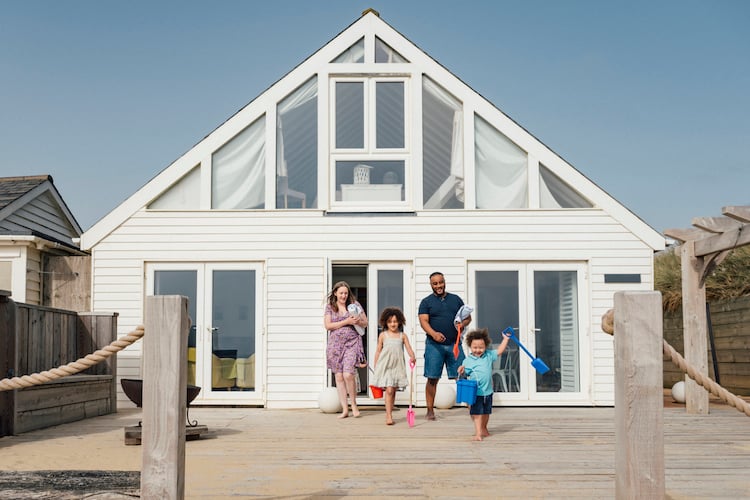A short-term rental (STR) business offers property rented out on a nightly, weekly, or monthly basis. Depending on the location, guests may include leisure or business travelers or a combination of both. Since STRs are rented by the night, revenues can be higher than a long-term rental, but there is also more work involved.
In this article, we’ll discuss how investing in STRs could be a profitable business and cover 7 steps to starting an STR business from the ground up.
Key takeaways
- Factors such as location, dynamic pricing, and multichannel marketing can make an STR business more profitable.
- Key steps to creating an STR business include writing a business plan with specific and measurable goals, researching the best STR markets, and deciding on a property management strategy.
- Online platforms with STRs, traditional listing services, and networking are 3 ways to find STRs for sale.
Are STRs profitable?
In some of the best STR markets in the U.S., it currently takes just 14 days of occupancy (or less) each month to cover the mortgage payment, according to a report from Realtor.com on the best places to buy and cash in on the travel boom.
AirDNA, a company that specializes in STR analytics, notes that average revenue from STRs that were listed full time grew to $56,000 by the end of last year, the highest level ever.
While STRs may generate extra rental income and offer advantageous tax benefits, self-managing an STR requires a lot of work. There also are extra expenses to consider, such as booking fees and higher maintenance costs, due to frequent guest turnover.
Things that may help increase the odds of having a profitable short-term rental include:
- Selecting the best location.
- Understanding the target market.
- Using a dynamic pricing strategy.
- Marketing to create a steady stream of guests.
- Monitoring financial performance.

How to start a short-term rental business in 7 steps
There are several key steps involved when starting an STR business. Let’s take a closer look at each.
1. Create a business plan
A written business plan for STR investments can help an investor stay focused on the end game. The plan should describe specific, realistic, and measurable short- and long-term goals, such as the reason for investing in an STR and monthly and annual revenue goals.
An STR business plan also should include a detailed analysis of the costs involved. In addition to a large down payment of 30% or more, STRs also have other costs that rentals occupied by long-term tenants don’t have, such as utilities, more frequent cleaning and repairs due to greater guest turnover, and keeping the STR fully furnished with the latest amenities.
2. Make the business legal
Regulations of STRs vary from place to place, and even by neighborhood homeowner associations (HOAs). Before purchasing an STR, it’s important to understand the rules. Airbnb has a list of general info about local regulations for most major cities in the U.S.
An owner of an STR also may be required to collect a lodging tax from guests and file a monthly tax return with the city and state the property is located in, along with obtaining a relevant business license. A local real estate attorney or property management company are good resources for learning more about local STR laws.
3. Find the best location
While STRs can be found virtually everywhere, some places are better than others. This article on the best STR markets compiles data from Lodgify, Mashvisor, and Realtor.com to find the best STR markets for 2022.
Each of the 3 reports used different metrics when deciding what markets are “best,” such as cap rate, cash-on-cash return, and the number of rented days each month required to generate enough revenue to pay for the mortgage.
Although researchers used different criteria, many of the best STR markets have small populations but a wide variety of amenities, year-round attractions, and are within a day’s drive of major metro areas, making many of the best markets perfect for a long weekend getaway.
The Roofstock STR Marketplace is a good resource to use to search for a property in popular locations. Listings may include an existing guest list and a record of historical financial performance. Buying a property that has been previously used as an STR can be a good way of jump-starting the STR business.
4. Select a management strategy
Some STR investors choose to manage a property themselves, while investors who own an STR in another state hire a professional property management company that specializes in STRs.
There are pros and cons to each STR property management strategy. Before making a decision, there are several issues investors may wish to consider, including:
- How will guest inquiries, booking confirmations, calendar updates, and guest arrivals be handled?
- Who will take care of quickly cleaning the STR, making any needed repairs, and restocking kitchen and bath items before the next guests arrive?
- Does an investor have a guest-centric, hospitality mindset to generate 5-star reviews, or is a local professional better suited to be a concierge?
5. Understand how pricing works
While long-term rental rates are generally adjusted once a year, nightly pricing for an STR may fluctuate from one week to the next, or even over different nights. Factors affecting STR pricing include seasonality, competition, length of stay, and even how many times a property has been viewed on a listing platform.
For example, an STR property focused on weekend getaways may offer a discounted rate during the week. On the other hand, investors with an STR frequented by business travelers might offer a weekend price reduction. To help maximize annual revenues from an STR, some investors look for longer-term renters during the low season to keep cash flow up.
6. List on booking sites
While there’s a growing demand from guests for STRs, there’s also a lot of competition. According to the 2022 STR forecast from AirDNA, demand is projected to increase by 14.1%, while listings are expected to grow by 15%.
In order to help generate a consistent booking flow, it’s important to remain competitive by listing on multiple channels. Some of the top short-term and vacation rental listing platforms to consider include:
- Airbnb
- Vrbo
- Booking.com
- Expedia
- TripAdvisor
Most short-term booking platforms use a ranking system based on host and guest reviews. To rank higher, many owners make it easy for guests to leave positive reviews by providing a template, offer a flexible cancellation policy, and provide outstanding amenities and service for a superior guest experience.
7. Choose a great software system
STR software systems can help owners schedule reservations, coordinate calendars across different booking platforms, manage maintenance and cleaning, and keep track of revenues. However, many services require a recurring subscription or collect a booking fee. For example, an all-in-one software solution such as Guesty generally collects a fee of between 2% and 5%, while pricing from Hostaway starts at $100 per month.
On the other hand, Stessa–a Roofstock company– is free to use for an STR business. After signing up for a free account and linking business and mortgage accounts, income and expenses can be automatically tracked for STRs.
Investors who already own an STR can download transaction files from Airbnb, then upload the data to Stessa. Numerous financial reports, like income and cash-flow reports, can be generated in just one click, and free resources from the Stessa Tax Center make year-end reporting a breeze.
Where to find a short-term rental investments
Great ways to find an STR property to purchase include speaking with local property management companies, working with a local real estate agent, and using an online marketplace like Roofstock.
The Roofstock STR Marketplace has properties listed for sale in popular U.S. markets, including Sun Belt hotspots like Kissimmee, FL; Orlando, FL; and Galveston, TX.
Typically, listed homes are furnished and include a history of financial performance. Instead of buying a home that’s never been rented before, investors can jump-start a vacation rental business with Roofstock.









